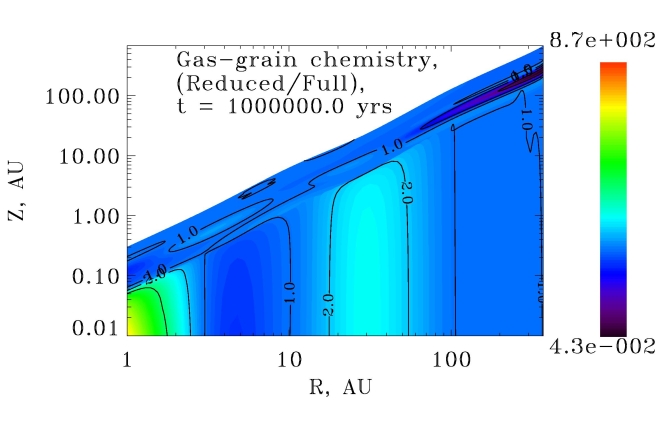
Note that all forementioned reduced networks are valid for the specified disk model and initial abundances!
This web page contains supplementary data to the article D.A. Semenov, D.S. Wiebe, & Th. Henning "Reduction of chemical networks. II. Fractional ionisation in protoplanetary discs" (2004), A&A, 417, 93. It include all those reduced networks that are cited in this paper along with the "full" network and two files with the physical conditions and initial abundances. The "full" network is based on the UMIST95 database of chemical reactions and can be downloaded here.
As initial abundances, we adopted a set of molecular abundances computed for the conditions typical of dark molecular clouds (T=10 K, nH=2000 cm-3, t=106 yrs) starting from the "low metal" abundances of Lee et al. (1996). This file can be found here.
We used the 1+1D disk model of
P. D'Alessio et al. (1999) as a guide for the physical conditions thought to be encountered in T Tau
protoplanetary disks. The disk is divided by 7 vertical and 11 radial grid slices. Then, we
estimated temperature (T ), density (r ),
intensity of the stellar (G0) and interstellar UV radiation, extinction
factors in vertical (AVIS) and radial (AVSt)
directions as well as X-ray (zX) and
cosmic ray (zCR) ionization rates in all these
77 disk grid points. The corresponding files for 7 vertical slices can be downloaded here:
Finally, for each considered disk point, we isolated a reduced chemical network which governs
the fractional ionization with better than 100% accuracy for the entire evolutionary time span
0.001 yrs<t<106 yrs. All these reduced networks can be found in
the following table:
| ri/zi,j | 0 | 1 | 2 | 3 | 4 | 5 | 6 | 7 | 8 | 9 | 10 |
| 1 AU | 5x3 | 58x142 | 39x78 | 30x58 | 26x105 | 26x105 | 28x166 | 26x70 | 5x5 | 5x5 | 5x5 |
| 3 AU | 13x14 | 60x102 | 62x142 | 62x218 | 115x308 | 20x85 | 19x77 | 39x173 | 31x84 | 17x46 | 17x46 |
| 10 AU | 94x246 | 94x246 | 113x364 | 29x88 | 29x88 | 18x52 | 18x52 | 19x77 | 18x52 | 18x52 | 18x52 |
| 30 AU | 18x40 | 18x40 | 18x40 | 18x40 | 18x40 | 19x77 | 17x46 | 17x46 | 17x46 | 17x46 | 17x46 |
| 100 AU | 19x40 | 19x40 | 19x40 | 19x40 | 64x204 | 19x77 | 19x77 | 19x77 | 19x77 | 19x77 | 19x77 |
| 300 AU | 19x40 | 19x40 | 19x40 | 19x40 | 96x407 | 19x77 | 25x170 | 19x77 | 19x77 | 19x77 | 19x77 |
| 370 AU | 19x40 | 19x40 | 19x40 | 19x40 | 95x399 | 19x77 | 19x77 | 19x77 | 19x77 | 19x77 | 19x77 |
In addition to the individual reduced network, we combined from them a SIngle REduced Network
for the whole disk (SIREN). This network includes 113 species involved in
518 reactions and allows to compute disk fractional ionization with reasonable
accuracy of less than 100% for entire 1 Myr evolutionary time span and all
disk locations but inner disk midplane. It can be downloaded here.
The ratio between fractional ionizations computed with SIREN and "full"
networks for t=106 yrs is presented below:

Note that all forementioned reduced networks are valid for the specified disk model
and initial abundances!